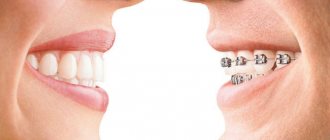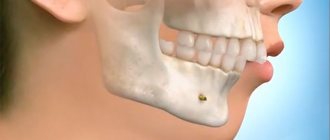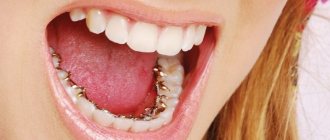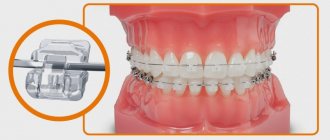These systems are the most effective for correcting malocclusions, etc. However, eating with braces is significantly complicated for a number of reasons. After installing the system, the orthodontist must advise the patient on how to eat with braces, which foods can be eaten and which cannot, etc.
Braces are becoming a big problem for children and their parents. It is difficult to explain to a child why this or that product should not be consumed, so adults should first of all understand this issue, and then convey this information to the child.
What can you eat in the first days after getting braces?
Almost immediately after fixing the brace system in the oral cavity, the patient will experience unpleasant sensations associated with increased pressure on the dentition. Chewing may cause severe pain. Therefore, experts recommend in the first days to give preference to soft and strained food. The following products and dishes are optimal:
- liquid porridge;
- soups;
- cottage cheese;
- kefir;
- yoghurts;
- jelly;
- vegetable puree, etc.
Recommendations for cleaning braces
The braces system requires daily care and cleaning. To do this you need to purchase the following devices:
- V-shaped brush.
- Cleaners.
- Super floss.
- Irrigator.
- Mouth rinses.
- Orthodontic wax (for application to individual structural elements to avoid damage to the mucous membranes).
Cleaning the mouth should be done no later than 10 minutes after eating. Each tooth should be brushed for at least 10 seconds, paying attention to each bracket and archwire. During the procedure, you need to rinse your mouth frequently to remove food from hard-to-reach places.
The final step is to clean the spaces between your teeth using dental floss and then rinse again.
What food is preferred throughout treatment?
When the patient gets used to the brace system, you can gradually expand the diet. The following is a list of products that will not cause any harm to the orthodontic structure:
- soups;
- yoghurts, kefir;
- soft cheeses;
- soft chicken fillet, thin sliced meat;
- fish, crab sticks;
- eggs;
- pasta;
- boiled rice;
- mashed potatoes;
- soft pastries, pancakes, bread crumbs;
- applesauce;
- bananas;
- jelly;
- milkshakes;
- vegetable caviar, stewed vegetables;
- cutlets, pureed meat.
The list of recommended products is quite large. It is important to understand that you should not bite hard food with your teeth. But if, for example, you grate an apple or carrot, you can eat them without fear for the safety of your braces.
Good to know. Braces are the best “nutritionist”. By adhering to some dietary restrictions, patients will receive not only straight and beautiful teeth, but also a slender figure.
Optimal food temperature
The temperature of the food consumed is important. It must be strictly controlled to avoid negative consequences.
Food should not be cold or hot. Sudden temperature changes are especially dangerous because they lead to microcracks in tooth enamel. In addition, the structure can be cooled or heated, while maintaining the temperature for a long time. In this case, it is a catalyst for harmful effects.
Food of low or high temperature negatively affects the glue that fixes the system on the surface of the teeth. So it can come off easily.
When alternating contrasting temperatures (washing down ice cream with hot coffee), the design may change its color when interacting with heat-sensitive components. This not only affects its appearance, but can also lead to the destruction and replacement of the system.
Orthodontists and dentists recommend adhering to the following rules:
- Do not eat foods that are scalding hot. It should be as comfortable as possible for the oral cavity and tooth enamel, and not cause discomfort.
- Frozen fruits and berries are not recommended to be consumed immediately. You should wait until they defrost and reach a comfortable temperature.
- Eating ice cream is acceptable, but should be done as little as possible. Some experts believe that you should not eat ice cream while wearing braces, but this is not true. It is recommended to eat it with a spoon, separating small pieces. They must be placed just outside the dentition. It is highly undesirable to bite off whole pieces of ice cream with your teeth.
Can braces come off?
The system is securely, but not tightly, attached to a special glue, and when biting on some products, its elements may come off. This most often occurs when eating solid foods. If one or more braces come off, you need to consult a doctor.
You can install braces at the Saint-Dent Clinic in Moscow. Qualified dentists of all specializations work here. The clinic uses advanced technologies and modern materials to treat patients. The contact page is located here Contacts. Patients can find out the cost of dental services here Prices for dental services.
What products are prohibited?
Of course, after some time the diet can be expanded. However, some things are best avoided until the moment your braces are removed. For example, biting into very hard fruits or vegetables, crackers and nuts can break the metal wire that connects all the staples. When an archwire is damaged, the pressure exerted on the teeth immediately changes. As a result, treatment may be less effective or completely useless.
Dense and sticky foods can cause staples to peel off from the enamel. Of course, thanks to the use of dental glue, they are attached quite reliably, but it is better not to take risks. First of all, you should give up foods such as seeds, nuts, dried fruits, crackers, caramel, candies, apples, carrots, etc.
In addition, sticky products are also prohibited. This includes toffee, nougat, dried fruits, cheese and much more. They can stick to the surface of the braces and accumulate in hard-to-reach places under the archwire and brackets. Removing them even with a toothbrush and irrigator can be very problematic. It is recommended to limit the consumption of fresh bread, chewing gum and even corn flakes. Dentists advise you to temporarily stop eating coloring foods, for example, beets, candies with a high content of dyes, etc. Otherwise, the staples may become stained and lose their attractive appearance.
Hard and sticky food
Eating solid foods leads to damage to the arch structure and displacement of the dentition. This also often causes locks to come unstuck. The following products are completely prohibited:
- nuts;
- crackers;
- seeds;
- hard treats (lollipops, caramels);
- hard fruits and vegetables.
Sticky and viscous products heavily contaminate the teeth and components of the orthodontic apparatus and are quite difficult to remove. They also cause the development of caries and inflammatory processes in the gums. You should refuse:
- soft sticky candies;
- chips;
- buns
- corn sticks and flakes;
- cheese;
- chewing gum.
In any case, braces mean discomfort when eating. Do you really need braces as your doctor advises?
I want to know more about aligners!
Orthodontist, candidate of medical sciences Tatyana Vladimirovna Gevorkyan comments:
— By the way, some patients (but more often female patients) are even enthusiastic about the idea that they will eat less and, as a result, lose weight.
Losing weight with braces? - original thought)
- True, this inspiration for the desire to lose weight, limiting one’s diet while wearing braces, does not always last for the entire course of treatment, but that’s another topic. In fact, braces do impose some restrictions, but not so strict and cruel.
And these restrictions apply not so much to food products, but to the process of eating. When undergoing orthodontic treatment with braces, orthodontists recommend grinding food, but not turning it into a homogeneous slurry. You can chop food with a fork and knife so that a person does not make biting movements.
Yes, those who like to bite crispy green apples will have to get used to the knife, so as not to accidentally peel off the bracket when biting. The same goes for tough meat or other tough foods. Only nuts, crackers, and toffees (popularly called “sealers”) are strictly prohibited when eating while wearing braces. But it’s unlikely that we all have a serious habit of consuming these products every day. Therefore, real gourmets should not fall into a trance at the thought that there is little they can afford to eat with braces.
Hot and cold food
Even people with absolutely healthy teeth should not expose their teeth to sudden temperature changes. And if a person wears braces, eating too hot and cold food is completely prohibited. This is especially true for bracket systems, which contain thermoactive elements that can change their properties under the influence of temperature.
You should avoid the following foods:
- cold ice cream and desserts;
- hot soup;
- scalding coffee, tea and other drinks.
Gum
What is dangerous: can stick to the orthodontic system. Verdict: not confirmed.
Chewing gum came next. This happened by accident, I ran out of mint candies, but I really needed them, and I decided to carefully try to chew them. And voila! nothing got stuck anywhere. But I think you still need to do this with caution and not let the chewing gum come into contact with the braces. I’m generally afraid to try toffees, because it can be difficult to simply clean them from teeth, and in general people even dislocate their jaws because of them.
Drinking alcohol and smoking during braces treatment
Drinking alcoholic beverages is undesirable, as they contain large amounts of sugar, which has a destructive effect on teeth. After drinking even a small amount of alcohol, a wearer of braces will have to brush their teeth. If this is not done, in the future you will have to deal with caries and inflammatory processes of the gums. In addition, alcohol leads to dry mouth. And this entails the occurrence of wounds and ulcers.
Smoking can spoil the appearance of the structure by staining some elements. It also leads to staining of tooth enamel, but in the places where braces are attached, the enamel will remain the same color. As a result, after removing the system, contrasting stains will be visible on the teeth. It is very difficult to even out the color, since nicotine is difficult to lighten. If you cannot completely quit smoking, you must at least reduce the number of cigarettes you smoke.
What not to do with braces
When wearing braces on your teeth, you will have to get rid of some bad habits, which include:
- chewing the tip of a pen or pencil;
- nail biting;
- drinking alcohol, etc.
When installing a system, many people wonder why they should not drink alcohol. The reason for this is their high content of sugars and other substances that have a bad effect on the enamel, forming a hard coating on it. When they settle on its surface, they cause caries and discoloration of the enamel. In addition, particles deposited on the structure can lead to gradual deformation and a change in its shade.
Alcoholic drinks are also dangerous because they dry out the oral cavity, making it vulnerable to various negative factors. Thus, structural elements can injure the gums, enamel and oral mucosa.
Advice from professionals
- If the orthodontist has given the patient specific recommendations regarding what foods should absolutely not be consumed during treatment, they should be strictly followed.
- You can only chew soft foods with your front teeth. It is better to chew other foods with your back teeth.
- If the patient feels hungry and has tooth pain at the same time, it is worth drinking a cool smoothie or milkshake. The cold will ease the pain, and the drink will reduce the feeling of hunger.
- In the first days after installing the braces system, you should not touch your lower teeth to your upper teeth, as this can cause pain.
Rules for daily hygiene care
If you have braces, you should make it a rule to take care of your teeth every day - morning, evening and after every snack. This will help maintain healthy teeth and a snow-white shade of enamel after removing braces.
- Brush your teeth with a brush and toothpaste in the morning and evening. If you have a special brush, it is necessary to carry out horizontal movements along the arch of the braces (there is a recess inside the bristles for the arch). Use a regular brush without strong pressure, using both horizontal and vertical movements. Move the head actively, clean each record separately,
- After the main cleaning, use a single-tuft brush or brushes to clean every gap between the brackets/archwires, the surface of the teeth, as well as the plates themselves, top and bottom. Pay special attention to the brackets that are located on the farthest teeth - it is on them that the largest amount of plaque accumulates, since it is with these elements that we chew food,
- Rinse your mouth with water and mouthwash for 1-2 minutes.
Cleaning can also be supplemented with an irrigator (can also be directed at the plates - the pressure should be reduced only in the presence of ceramic and sapphire systems) and dental floss.
Do braces damage enamel and lead to caries?
No, the tight fit of the braces completely eliminates the penetration of food debris and microbes into the tooth; Dental enamel glue used in practice is harmless, moreover, it contains the useful element fluorine. The brace-lock even protects the tooth in a certain way.
But improper care of braces is really fraught with trouble: oral hygiene after installation of an orthopedic structure requires more attention and responsibility due to the increased accumulation of plaque. And where there is plaque, there is caries!
In any case, braces mean discomfort when eating. Do you really need braces as your doctor advises?
Are you ready to carry this pile of iron in the form of metal and ceramic braces in your mouth for the entire duration of treatment (a year or two)?
Rub your tongue against them, polish them until they shine, eliminating pieces of food? Braces when eating are uncomfortable and not aesthetically pleasing. Consider treatment with aligners. There will be no problems at all when eating - food will not get stuck in them and your breath will not smell bad. The Star Smile company operates in more than 70 cities of Russia and will be able to offer you competent consultation with an orthodontist in your city. And the prices will pleasantly surprise you, because Star Smile has the lowest prices with excellent quality of treatment. Take the first step towards comfortable treatment.











